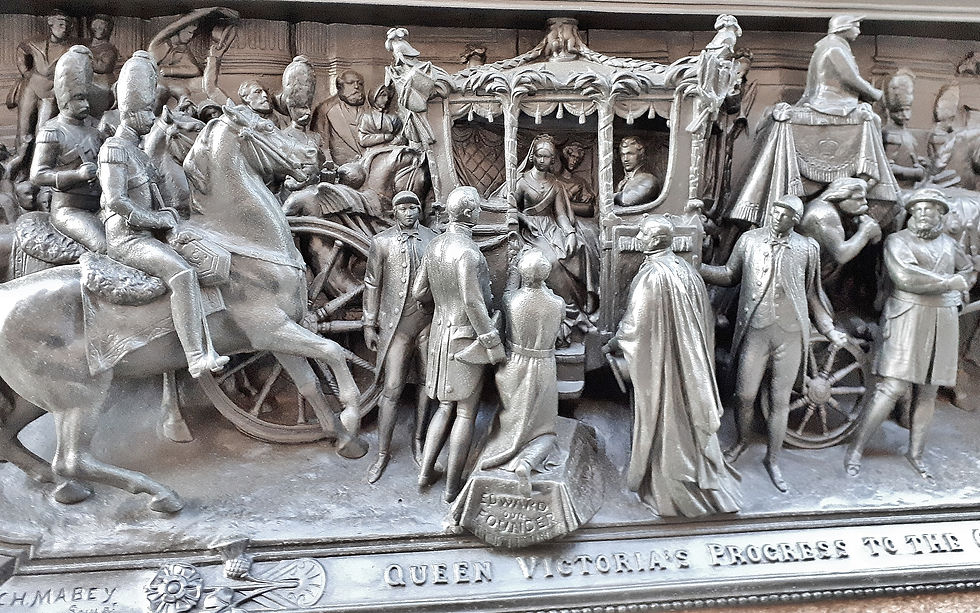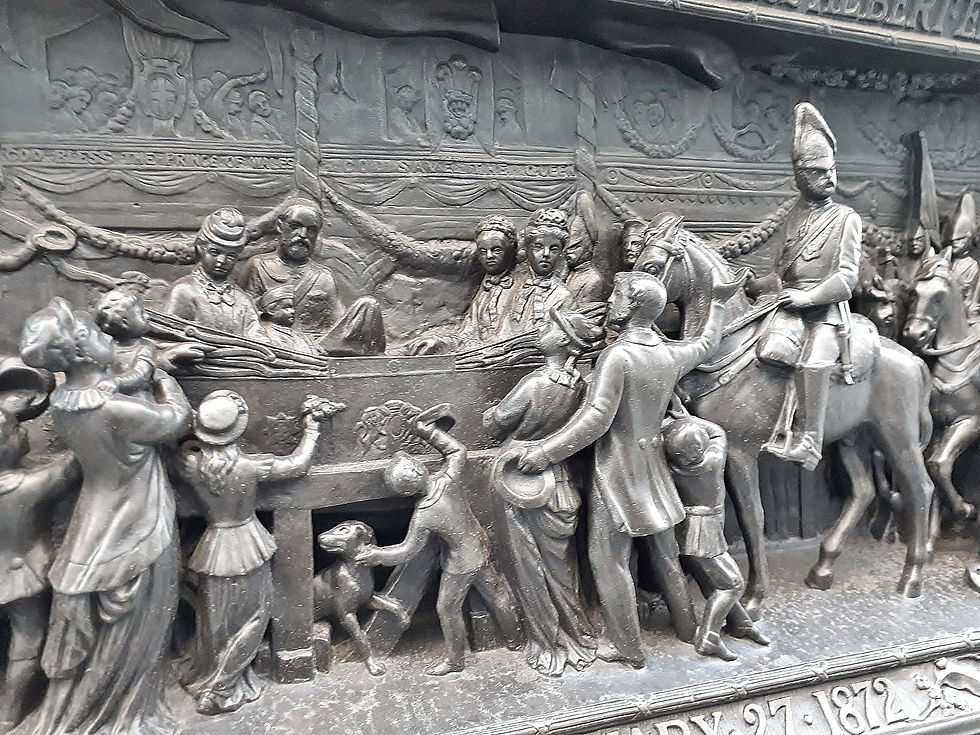Temple Bar Memorial: Victorian delights you may not have noticed
- London On The Ground

- Feb 2, 2024
- 6 min read
The fearsome dragon is impressive, but the plinth contains hidden treasures.

Temple Bar Memorial, where The Strand becomes Fleet Street, marks the Western entrance to the City of London from Westminster. It stands outside the Royal Courts of Justice on the spot where Temple Bar, a stone gate, once stood. Designed by the City of London architect Sir Horace Jones and topped by a bronze dragon sculpted by Charles Bell Birch, it was erected in 1880.

To read about the City of London's other, newer, fire-breathing boundary markers see City of London: dragons' den. Incidentally, contrary to a popular misconception, the City's dragons are most definitely not griffins.
Walks available for booking
For a schedule of forthcoming London On The Ground guided walks, please click here.
The stone gate that the Memorial replaced was designed by Sir Christopher Wren in around 1670 to replace a Tudor gate, but there had previously been various forms of barrier here since at least the 1200s.
Wren's Temple Bar was taken down to allow for road widening in 1878, but its location was marked with Jones' 1880 memorial. After being relocated to Hertfordshire for more than a century, the Wren gateway was rebuilt between St Paul's Churchyard and Paternoster Square in 2004.
You can go into the room above the historic gateway as part of a walking tour I lead for Temple Bar Trust (click here for more details and the next available date).

Temple Bar Memorial's dragon is its most visible feature, but there is much more to it than that. For those brave enough to cross into the street and stand on the narrow traffic island around the Memorial, its plinth is rich with statues and sculptures that are just a little too distant to see in detail from the main pavement.
In the niche in the upper part of the plinth's south side is a statue of Queen Victoria, sculpted in Sicilian marble by Sir Joseph Boehm. Wearing a gilded crown and holding a gilded sceptre and orb, she is flanked by symbols of science and art. Victoria was the last monarch to enter the City of London through the old Temple Bar before it was removed.

Contrary to an often repeated popular myth, the Monarch does not have to ask permission to enter the City. Like all myths, this one has some grounding in truth. It is a misinterpretation of the Ceremony of the Pearl Sword, which dates back to Elizabeth I and signifies the Lord Mayor's loyalty to, and protection of, the monarch while the Sovereign is in the City.
For more on the Ceremony of the Pearl Sword and an account of the many other statues of English Queens nearby in the City of London, see Old Queens: Ten of Six in the City.
A bronze relief of Queen Victoria's first visit to the City as Monarch has details that will more than reward you for crossing into the middle of Fleet Street. It is below her statue on the south side of the Memorial's plinth.
In her first public appearance after succeeding to the throne, the 18 year old Sovereign travelled to Guildhall to attend the Mayoral Banquet of the newly installed Lord Mayor, Sir John Cowan.
The bronze relief, by Charles Mabey, captures the scene as the Queen's Gold State Coach pauses at St Paul's Cathedral en route to the banquet in a grand procession along streets lined with excited crowds. Details of the Cathedral are recognisable in the background.

The Lord Mayor, mounted, robed and wearing his chain of office, approaches from right of centre, holding the Pearl Sword (whose blade is incomplete). Behind him, the City Sword Bearer, in his Muscovy fur hat and with tassels hanging from his cloak, struggles to control his horse. A third mounted figure on the right hand side, the City's Common Cryer and Serjeant-at-Arms, wearing a wig, carries the Great Mace.
One initially puzzling detail is the man emerging from beneath the coachman's seat, apparently eating a peeled banana, or perhaps swigging from a bottle. However, relax, this is not a rowdy interloper. He is part of the Gold State Coach itself, one of its four carved and gilded tritons (mythical sea gods), blowing a conch. (The same coach featured in King Charles III's Coronation last year).

Beside the Royal coach, its door held open by a footman, is a senior pupil from Christ's Hospital, escorted by the school's headmaster and treasurer. He is giving the Queen a scroll containing his loyal address, while kneeling on a hassock bearing the words "Edward our founder" and "Victoria our friend".

Christ's Hospital is a charitable school founded in the City of London by Edward VI in 1552. It is now located in Sussex, but retains links with the City (see The City of London's only modern sculpture of school children). By tradition, the Senior Grecian (head student) of the school gives a loyal address to new monarchs on their first visit to the City of London after their coronation.
The Senior Grecian's loyal address to Victoria was also painted and can be seen on the Christ's Hospital Museum website here. More recently, the school's Senior Grecian addressed King Charles at a dinner at Mansion House on 18 October 2023.
The frieze shows cheering onlookers in the background on what was an important day of national celebration. However, true to the image that history has handed down of her, the young Queen looks distinctly unamused. Perhaps she is concerned that two mounted guardsmen arriving from the left appear to be about to crash into the City officials.

Below the scene, the name of the sculptor, CH (Charles Henry) Mabey, is inscribed on the left hand side, followed by 'Queen Victoria's progress to the Guildhall, London, Nov 9th 1837'.
Engravings by Nathanial Whittock of Victoria's procession through London that day, showing what a huge occasion it was, can be seen at the London Picture Archive website here and here.
On the north side of Temple Bar Memorial is Sir Joseph Boehm's marble statue of the Prince of Wales, the eldest son of Queen Victoria, who became Edward VII in 1901. He is flanked by the same symbols of science and art as his mother.

Below this statue is a bronze relief portraying the Prince and Princess of Wales accompanying the Queen on their way to St Paul's for a service of thanksgiving for the Prince's recovery from typhoid in 1872. This was the last time that a reigning monarch entered the City of London through the old Temple Bar gateway before it was removed in 1878.
The bronze, by Charles Samuel Kelsey, is entitled 'Her Most Gracious Majesty Queen Victoria and His Royal Highness Albert Edward Prince of Wales going to St Paul's February 27 1872'. Kelsey shows police attempting to hold back the crowds as they swarm around the Royal carriage.


A smaller bronze relief by Charles Mabey on the east side of the Memorial (facing the City) shows two angels drawing a curtain across Wren's Temple Bar, a symbolic farewell to the old gate.

On the upper part of the plinth's west side (facing Westminster), symbols of war and peace are carved in stone. In the centre is a relief portrait of the 16 year old Prince Albert Victor, son of the Prince of Wales and grandson of the Queen. Second in line to the throne at the time, he pre-deceased both his father and his grandmother six days after his 28th birthday, after contracting the flu.

Mabey's third bronze relief, lower down on the west side, notes that the Memorial was erected during the Mayoralty of Sir Francis Wyatt Truscott (whose face is carved in stone in the middle of the upper part of the plinth's east side). It also records the name of the Chairman of the Committee for letting City Lands, John Thomas Bedford; the Contractors, Messrs John Mowlem & Co; and the architect, Horace Jones.
It also tells us that this west side of the plinth is coincidental with the west side of the old gateway and that its centre east-west line was 3 feet 10 inches south of the golden arrow marked on the panel.

Of greater visual interest on this relief are the figures of the two giants Gog and Magog, legendary guardians of the City of London, whose wicker effigies still take part in the annual Lord Mayor's Show every November.
The name 'Temple Bar' derives from the neighbouring Temple area, which has 12th century origins, (see Knights of the Round Church at London's Temple) and the wooden bar that likely formed the early barrier across the road here.
Temple Bar Memorial embodies many centuries of the history of London and the Monarchy. The best vantage point to look at the dragon is from the upper deck of a London bus. For the more detailed statues and friezes, braving the traffic and crossing by foot to look at the plinth is well worth it.
Walks available for booking
For a schedule of forthcoming London On The Ground guided walks, please click here.
My talk on Shakespeare's London
A recording of a talk I gave at Guildhall Library on 14 December 2023, entitled Shakespeare, London and the First Folio, is now available on my YouTube channel:
If you don't already subscribe, please sign up for email updates on my blog publications and walk schedules by entering your details in the form below. Please also follow me on social media via the links at the bottom of this page. Thank you!












Comments